MP Board Class 12th Chemistry Important Questions Chapter 9 Coordination Compounds
Coordination Compounds Important Questions
Coordination Compounds Objective Type Questions
Question 1.
Choose the correct answer:
Question 1.
The correct structural formula of Zeise’s salt is :
(a) K+ [PtCl3(C2H4)]–
(b) K+[PtCl2(η2 – C2H4)–]Cl–
(c) K+[PtCl3(η2 – C2H4)]
(d) K+PtCl3(η2 – C2H4)]–
Answer:
(a) K+ [PtCl3(C2H4)]–
Question 2.
AgCl is soluble in aqueous ammonia due to formation of:
(a) [Ag(NH3)2]2+
(b) [Ag(NH4)2]+
(c) [Ag(NH3)4]+
(d) [Ag(NH3)2]+.
Answer:
(d) [Ag(NH3)2]+.
Question 3.
Which of the following gives a white precipitate in aqueous solution with silver nitrate:
(a) [Cr(NH3)5Cl](NO2)2
(b) [Pt(NH3)3Cl2]
(c) [Pt(CN)2Cl2]
(d) [Pt(NH3)2]Cl2.
Answer:
(d) [Pt(NH3)2]Cl2.
![]()
Question 4.
Correct nomenclature of Fe4[Fe(CN)6]3 is :
(a) Ferroso ferric cyanide
(b) Ferric ferrous hexacyanate
(c) Iron (III) Hexacyanoferrate
(d) Hexacyanoferrate (III-II).
Answer:
(c) Iron (III) Hexacyanoferrate
Question 5.
In which of the following compounds oxidation state of metal is zero :
(a) [Pt(NH3)2Cl2]
(b) [Cr(CO)6]
(c) [Cr(NH3)3Cl3]
(d) [Cr(CN)2Cl2]
Answer:
(b) [Cr(CO)6]
Question 6.
Example of dsp2 hybridization is :
(a) [Fe(CN)6]-3
(b) [Ni(CN)4]-2
(c) [Zn(NH3)4]+2
(d) [FeF6]-3
Answer:
(b) [Ni(CN)4]-2
Question 7.
Which of the following complex is used as anti-cancer agent:
(a) Trsns[CO(NH3)2Cl3]
(b) cis[Pt(NH3)2Cl2]
(c) cisK2[PtCl2Br2]
(d) Na2CO3.
Answer:
(b) cis[Pt(NH3)2Cl2]
Question 8.
Oxidation state of Fe in [Fe(CO)3] complex is :
(a) -1
(b) +2
(c) + 4
(d) 0
Answer:
(d) 0
Question 9.
Grignard reagent is :
(a) Organometallic compound
(b) Complex compound
(c) Double salt
(d) Neutral compound.
Answer:
(c) Double salt
Question 10.
Structure of complex salt was proposed by :
(a) Berzelius
(b) Werner
(c) Raoult
(d) Faraday.
Answer:
(b) Werner
![]()
Question 11.
Mohr’s salt is :
(a) Double salt
(b) Complex salt
(c) Neutral salt
(d) Reagent.
Answer:
(a) Double salt
Question 12.
The formula of nitroprusside is :
(a) Na4[Fe(CN)5NO5]
(b) Na2[Fe(CN)5NO]
(c) NaFe[Fe(CN)6]
(d) Na2[Fe(CN)6NO2].
Answer:
(b) Na2[Fe(CN)5NO]
Question 13.
Which of the following is not an organometallic compound : (MP 2018)
(a) C2H5MgBr
(b) (C2H5)4Pb
(c) C2H5ONa
(d) (CH3)4Al.
Answer:
(b) (C2H5)4Pb
Question 14.
Zeigler Natta catalyst is :
(a) (Ph3P)3RhCl
(b) K[PtCl3(C2H4)]
(c) [Al2(C2H6)6]
(d) [Fe(C2H5)2].
Answer:
(a) (Ph3P)3RhCl
Question 15.
The I.U.P.A.C. name of [Ni(CO)4] is :
(a) Tetracarbonyl nickelate (0)
(b) Tetracarbonyl nickelate (II)
(c) Tetracarbonyl nickel (0)
(d) Tetracarbonyl nickel (II)
Answer:
(c) Tetracarbonyl nickel (0)
Question 2.
Fill in the blanks :
- Cis [Pt(NH3)2Cl2] complex is used as an ……………. agent.
- Haemoglobin is a ……………. compound of iron.
- Geometrical isomerism is found in both ……………. and ……………. complexes.
- Oxidation state of Ni in Ni(CO)4 is …………….
- Diethyl zinc is a ……………. compound.
- The correct I.U.P.A.C. name of K4[Fe(CN)6] is …………….
- Oxidation state of Co in [Co (E.D.T.A)] is …………….
- The formula of dibromo chlorotriaquo chromium (III) is …………….
- [COF6]-3 is a ……………. spin complex.
- The formula of antiknock organometallic substance is …………….
- E. D. T. A is ……………. ligand.
- Example of hexadentate ligand is …………….
Answer:
- Anti – cancer
- Complex
- Tetrahedral, Octahedral
- Zero
- Organometallic compound
- Potassium hexacyano ferrate (II)
- +3,8. [Cr(H2O)3Cl Br2]
- High
- Tetraethyl lead (C2H5)4Pb
- Hexadentate
- E.D.T.A.
Question 3.
Match the following :
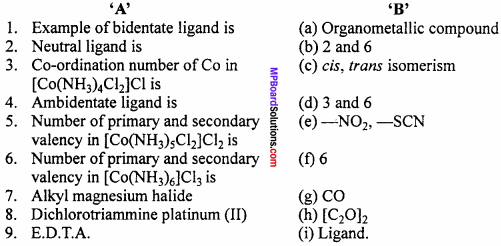
Answer:
- (h)
- (g)
- (f)
- (e)
- (b)
- (d)
- (a)
- (c)
- (i)
![]()
Question 4.
Answer in one word/sentence :
- Which type of isomerism is found in [CO(NH3)5Br]SO4 and [CO(NH3)5SO4]Br?
- Name the organometallic compound which is used as an antiknock compound in petrol. (MP2018)
- Complexes of E.D.T.A. formed with calcium is used to remove the poisoning caused due to which metal?
- How is the structure of dibenzene?
- What type of hybridization is found in [Ni(CO)4]?
- Which type of isomerism is represented by [Cr(H2O)5SCN]2+ and [Cr(H2O)5NCS]2+?
Answer:
- Ionization isomerism
- Tetraethyl lead
- Lead
- Sandwich
- sp3
- Linkage isomerism.
Coordination Compounds Very Short Answer Type Questions
Question 1.
Among the following ions, whose magnetic moment value will be maximum. (NCERT)
- [Cr(H2O)6]3+
- [Fe(H2O)6]2+
- [Zn(H20)6]2+.
Answer:
2. [Fe(H2O)6]2+.
Question 2.
Write two examples of monodentate ligands.
Answer:
NO+ (Nitrosonium), NH2NH3 (Hydrazinium).
Question 3.
What will be the geometry of [Cr(NH3)6]3+ complex ion?
Answer:
Tetrahedral.
Question 4.
Write IUPAC name of the complex : [Pt(NH3)4][PtCl4].
Answer:
Tetraammine platinum (II) tetrachloridoplatinate (II).
Question 5.
What is the hybridization of Fe in the complex ion [Fe(CN)6]3-?
Answer:
Hybridization of Fe in the complex [Fe(CN)6]3- is d2sp3.
![]()
Question 6.
State the full name of EDTA.
Answer:
Ethylene diammine tetraacetate ion.
Question 7.
Which are eg orbitals?
Answer:
dx2 – y2 and dz2 are eg orbitals.
Question 8.
Give an example of a neutral bidentate ligand.
Answer:
Ethylene diamine

Question 9.
Why is geometrical isomerism not possible in tetrahedral complexes having two different types of unidentate ligand co – ordinated with the central metal ion?
Answer:
Tetrahedral complexes do not show geometrical isomerism because the relative positions of the unidentate ligands attached to the central metal atom are the some with respect to each other.
Question 10.
State the magnetic property and hybridization of [Ni(CO)4J.
Answer:
Diamagnetic (All electrons paired) and sp3 hybridization.
Coordination Compounds Short Answer Type Questions
Question 1.
Explain double salt and complex salt. Give one – one example of each.
Answer:
Double salt: Double salts are additive compounds which are stable in the crystal lattice but when dissolved in water break into different compounds.
Example : Ferrous ammonium sulphate is a double salt which ionise in water as
FeSO4 (NH4)2 SO4 . H2O ⇌ Fe2+ + SO42- + 2(NH4)+ + SO42- + H2O
Complex salt:
The compounds in which ligand with lone-pair electron are linked with any metal atom or metal ion by coordinate bonds, are called coordination compounds. In these compounds metal ion and ligand in combined state act as complex ion and thus these compounds are also known as complex compounds.
Example: K4[Fe(CN)6].
Question 2.
What do you understand by ligand ? Explain giving example.
Answer:
Ligand:
Any atom, ion or molecule which can donate electron pair to central ion and forms co – ordinate bond are called ligand.
Example : In K4[Fe(CN)6], CN is ligand. (MPBoardSolutions.com) In ligand the specific atom which donates the electron pair is known as donor atom.
On the basis of number of donor atoms in a ligand, they are classified as monodentate, bidentate, tridentate, polydentate ligands. Some such ligands are given below :

In the ligand the asterisk atom is donor atom.
![]()
Question 3.
What is meant by the chelate effect? Give an example. (NCERT)
Answer:
When a ligand attaches to the metal ion in a manner that forms a ring, then the metal – ligand association is found to be more stable. In other words, we can say that complexes containing chelate rings are more stable than complexes without rings. This is known as the chelate effect for example :
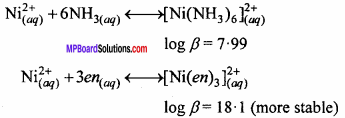
Question 4.
A solution of [Ni(H2O)6]2+ is green but a solution of [Ni(CN)4]2- is colourless. Explain. (NCERT)
Answer:
H2O is a weak ligand [Ni(H2O)6]2+ is a outer orbital complex. The complex has two unpaired electron. The d – d transition is possible. It absorbs red light and complementary green light is emitted.
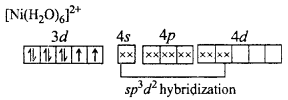
CN–is a strong ligand. The unpaired electrons are paired up. The central atoms undergoes dsp2 hybridization. Square planar complex is formed. No unpaired electrons are present i.e. d – d transition is not possible, hence the complex is colourless.
Question 5.
[Fe(CN)6]4+ and [Fe(H2O)6]2+ are of different colours in dilute solutions, why? (NCERT)
Answer:
In both the complexes, Fe is in +2 state with the configuration 3d6 i.e., it has four unpaired electrons. As the ligand H2O and CN– possess different crystal field splitting energy (Δ0), they absorb different components of the visible light (VIBGYOR) for d – d transition. Hence, the transmitted colours are different.
Question 6.
Discuss the nature of bonding in metal carbonyls. (NCERT)
Answer:
The metal carbon bonds in metal carbonyls have both s nad p characters. M – C σ – bond is formed by the donation of lone pair of electrons on the carbonyl carbon into a vacant orbital of the metal. M – C π – bond is formed by the donation of a pair of electrons from the filled metal d orbital into the vacant anti – bonding π * orbital of carbon monoxide. (MPBoardSolutions.com)
This is also known as back bonding of the carbonyl group. The metal to ligand bonding creates a synergic effect which strengthens the bond between CO and the metal. This synergic effect strengthens the bond between CO and the metal.
Question 7.
Give evidence that [CO(NH3)5Cl]SO4 and [CO(NH3)5SO4]Cl are ionization isomers. (NCERT)
Answer:
Ionisation isomers when dissolved in water furnish different ions which can be tested.

White precipitate of AgCl indicates that the isomer has Cl ion outside the co – ordination sphere.
![]()
White precipitate of BaSO4 indicates the isomer has SO42- ion outside the co – ordination sphere.
Question 8.
Explain optical isomerism in co – ordination compounds.
Answer:
Optical isomerism:
This type of isomerism is observed in such similar compounds which are the mirror images of each other and are non- superimposable. They rotate the path of plane polarized light to the left (l) or to the right (d).
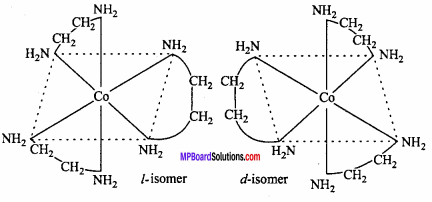
Question 9.
What is complex ion?
Answer:
Complex Ion:
A complex ion is an electrically charged redical or a species, carrying either positive or negative charge, in which the central metal ion is surrounded through co – ordinate bond by a suitable number of ligands (neutral molecules or negative ions).
Example:
Complex ferrocyanide ion[Fe(CN)6]4- is formed by the union of six CN–ions with one Fe2+ ion. While writing the formula of a complex ion, the co – ordinating groups are written inside the bracket ( ), and the whole of the complex ion in a square bracket [ ]. The net charges is written on right hand top comer of the square bracket. The square bracket is known as co – ordination sphere.
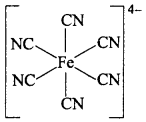
Question 10.
Give example of bidentate and hexadentate ligand.
Answer:
Bidentate ligand :

Hexadentate ligand:

Question 11.
What is co – ordination number? Give any two examples.
Answer:
Co – ordination number:
Number of ligands which are directly linked with central metal or metal ion by co – ordinate bonds, are co – ordination number.
Example:
- [CO(NH3)6]Cl3 co – ordination number of CO3+ ion is 6.
- In [Ag(CN)2] co – ordination number of Ag is 2.
![]()
Question 12.
What are organometallic compounds? Write its two applications
Answer:
Those compounds in which the carbon atom of organic groups are directly bonded to metal atoms are called organometallic compounds. The compound of element such as boron, phosphorus, silicon, germanium and antimony with organic groups are also included in the organometallics.
Applications of organometallic compounds :
- Tetraethyl lead (C2H5)4Pb is used as an antiknock compound.
- Ziegler – Natta catalysis is used in the polymerization of ethylene or other alkenes.
- Ethyl mercuric chloride (C2H5HgCl) is used in agriculture as an insecticide.
- Willkinson catalyst is used in the hydrogenation of some alkenes.
Question 13.
Explain geometrical isomerism with an example.
Answer:
Geometrical isomerism:
When the ligands are situated at different position around the metal it gives rise to geometrical isomerism. The isomer in which similar groups are in adjacent position (making an angle 90° with metal ion) is called cis – isomer. The isomer in which the similar group occupy the opposite position (making an angle of 180° with metal ion) is called transisomer. This type of isomerism is observed in square planar (CN = 4) and octahedral (CN = 6) type of complexes.
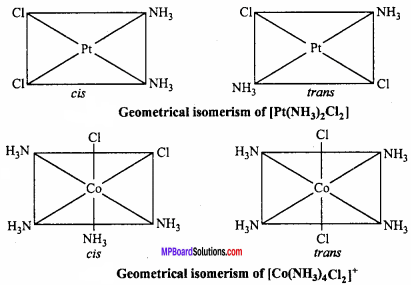
Question 14.
[NiCl4]2- is paramagnetic while [Ni(CO)4] is diamagnetic though both are tetrahedral. Why? (NCERT)
Answer:
[NiCl4]2- has 2 unpaired electrons and is paramagnetic (See Q. No. 4 for details). Like CN–, CO is also strong field ligand, same like CO, it causes pairing of electrons. No unpaired electrons left, hence it is diamagnetic.
Question 15.
[Fe(H4O)6 is strongly paramagnetic whereas [Fe(CN)6]3- is weakly paramagnetic. Explain. (NCERT)
Answer:
In both the complexes Fe is in +3 oxidation state with the configuration 3d5. CN– is a strong ligand. In its presence, 3d – electrons pair up leaving only one unpaired electron. The hybridization is d2sp3 forming inner orbital complex. H4O is a weak ligand. In its presence, 3d – electrons do not pair up. The hybridization is sp3 d2 forming an outer orbital complex containing five unpaired electrons. Hence, it is strongly paramagnetic.
![]()
Question 16.
Explain [CO(NH3)6]3+ is an inner orbital complex whereas [Ni(NH3)6]2+ is an outer orbital complex. (NCERT)
Answer:
In [CO(NH3)6]3+, CO is in +3 oxidation state with the configuration 3d6. In the presence of NH3, 3d – electrons pair up leaving two d – orbitals empty. Hence, the hybridization is d2sp3 forming an inner orbital complex.
In [Ni(NH3)6]2+, Ni is in +2 oxidation state with the configuration 3d6. In presence of NH3, the 3d – electrons do not pair up. The hybridization involved is sp3d2 forming outer orbital complex.
Question 17.
Write the IUPAC names of the following co – ordination compounds : (NCERT)
- [CO(NH3)6]C13
- [CO(NH3)5CI]C12
- K3[Fe(CN)6]
- K3[Fe(C2O4)3]
- K2[PdCl4]
- [Pt(NH3)2Cl(NH2CH3)]Cl.
Answer:
- Hexaammine cobalt(III) chloride
- Pentaamminechloridocobalt(III) chloride
- Potassium hexacyanoferrate(III)
- Potassium trioxalatoferrate(III)
- Potassium tetrachloridopalladate(II)
- Diamminechlorido(methanamine)platinum(II) chloride.
Question 18.
Explain the structure of [Ni(CO)4] on the basis of valence bond theory.
Answer:
Complexes in which the metal ion is sp3 hybridized represent tetrahedral geometry.
For example : Formation of tetracarbonylnickel (0) Can be explained by sp3 hybridization.
In [Ni(CO)4], Nickel is in zero oxidation state. Thus, outer electronic configuration of nickel is 3d8 4s3. CO is a strong ligand, thus due to the effect of ligand the 4s electrons move to 3d and make all the 3d electrons paired. This way, one 4s and three 4p become vacant and intermix to form equivalent

sp3 hybridization of [Ni(CO)4]

sp3 hybrid orbitals which are tetrahedrally oriented. These four hybrid orbitals overlap with lone electron pairs of
4CO and form sigma bond.
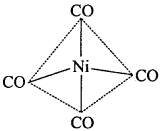
[Ni(CO)4] does not contain unpaired electron. Thus, it is diamagnetic and tetrahedral.
Question 19.
Explain the structure of [Zn(NH3)4]2+ on the basis of valence bond theory.
Answer:
Structure of [Zn(NH3)4]2+ Tetraammine zinc (II) ion:
Outer electronic configuration of zinc (Z = 30) in ground state is 3d104s2. In this complex zinc is in +2 oxidation state with the outer electronic configuration of 3d10.
The 3d orbital being completely filled does not take part in hybridization. The vacant 4s and 4p orbitals hybridize and form four hybridized sp3orbitals directed
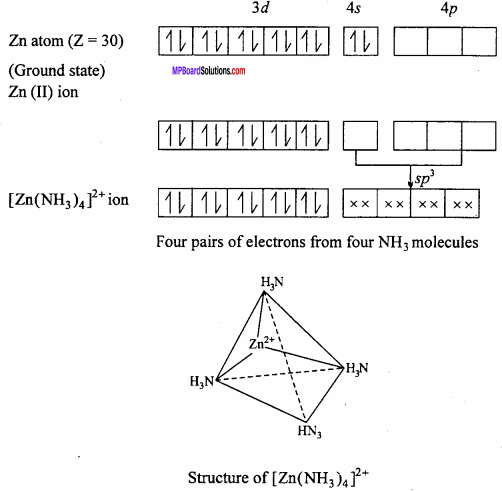
towards the four comers of a tetrahedron. The four lone pairs from four NH3 overlap with these sp3 orbitals and forms four σ – bonds. The compound is diamagnetic as it does not contain unpaired electrons.
![]()
Question 20.
Write IUPAC name of the following :
- [Pt(NH3)3 Cl2]
- K3[Fe(CN)6]
- [CO(NH3)6] Cl3
- Pt[(NH3)6] Cl4
- CuCl3.
Answer:
- Dichlorodiammine platinum (II)
- Potassium hexacyanoferrate (III)
- Hexaammine cobalt (III) chloride
- Hexaammine platinum (IV) chloride
- Tetrachlorocuprate (II)
Question 21.
1. Write I.U.P.A.C. name of

2. Write the ligands and co – ordination number of the complex [Cr (NH3)4(ONO) CI]NO3.
3. Write chemical formula of carbonate pentaammine cobalt (III) chloride.
Answer:
1. µ – amido – µ -hydroxobis – (tetraammine cobalt) (III) ion.
2. Ligands :
- NH3
- ONO
- Cl
Thus, number of ligands are 3 and co – ordination number is 6.
3. [CO(NH3)5CO3]Cl.
Question 22.
Using IUPAC norms write the formulas for the following :
- Tetrahydroxozincate(II)
- Potassium tetrachloridopalladate(II)
- Diamminedichloridoplatinum(II)
- Potassium tetracyanonickelate(II)
- Pentaamminenitrito-o-cobalt(III)
- Hexaamminecobalt(III) sulphate
- Potassium tri-(oxalato)chromate(III)
- HexaamminepIatinum(IV)
- Tetrabromidocuprate(II)
- Pentaamminenitrito-N-cobalt(III).
Answer:
- [Zn(OH]2
- K2[PdCl4]
- [Pt(NH3)3Cl2]
- K2[Ni(CN)4]
- [CO(NH3)5(ONO)]2+
- [CO(NH3)6]2 (SO4)3
- K3[Cr(C2O4)3]
- [Pt(NH3)6]4+
- [Cu(Br)4]2-
- [CO(NH3)5(NO2)]2+.
Question 23.
Write the I.U.P.A.C. names of the following compounds:
(i)
(a) [HgI4]2-
(b) [Ag (CN)2]–
(c) [Fe (C5H5)2]
(d) K [Ag (CN)2].
(ii) What is Zeise’s Salt and Ferrocene? Explain with structure.
Answer:
(i)
(a) Tetraiodomercurate (II) ion.
(b) Dicyanoargentate (I) ion.
(c) Bis (cyclopentadienyl) iron (II).
(d) Potassium dicyano argentate (I).
(ii)
(a) Zeise’s salt K [PtCl3 – η2(C2 H4 ) :
This salt was prepared by Danish pharmacist Zeise in 1830. It is one of the compound of transition metals which was prepared earlier. The plane of ethylene molecule and the C = C axis are perpendicular to the expected bond direction of the central atom.
(b) Ferrocene Fe (η5 – C5H5)2:
It is an orange yellow coloured compound. Kealy and Pauson reported it in 1951. It has sandwich structure in which iron atom is in between two cyclopentadienyl rings. The planes of the rings are parallel so that all the carbon atoms are equidistant from iron atom.
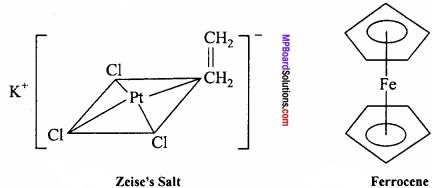
Question 24.
Explain Linkage and Ionisation isomerism with example.
Answer:
Linkage isomerism:
Linkage isomerism occurs when different atoms of the ligand are attached to the central metal ion. The structure obtained are called linkage isomers. Such type of ligands are called ambidentate ligand.
![]()
In structure I Ni2+ is linked by thiocyanate sulphur and in structure II it is linked by nitrogen atom.
Ionization Isomerism:
This type of isomerism is shown by such compounds which have same composition but liberate different ions in solution.
[CO(NH3)5Br] SO4 – It liberates SO2- ions.
[CO(NH3)5SO4]Br – It liberates Br– ions.
![]()
Question 25.
What is the difference between primary and secwraary valency? Give example also.
Answer:
Primary valency is ionisable while secondary valency does not ionise. Primary valency is represented in figure by solid lines and secondary valency by broken or dotted lines.
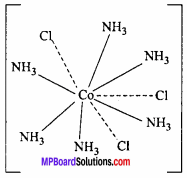
Example:
[CO (NH3)6] Cl3, primary valency is 3 and secondary valency is 6. Co – Central metal, NH3, Cl – Ligand.
Question 26.
What is effective atomic number (EAN)?
Answer:
In co – ordination compounds, sum of electrons present in central metal ion and electrons received in bond formation is called effective atomic number.
EAN = Atomic number – Electrons lost in ion formation + Electrons obtained in bond formation
In K4[Fe(CN)6] EAN for Fe = 26 – 2 + 12 = 36.
Coordination Compounds Long Answer Type Questions
Question 1.
Explain the bonding in co – ordination compounds in terms of Werner’s postulates. (NCERT)
Answer:
Werner’s co – ordination theory:
Alfred Werner gave his co – ordination theory in 1893. The important postulates of this theory are :
1. All metals in atomic or ionic form exhibit two types of valencies in co – ordination compounds :
- Primary or principal or ionic valency ( ….. )
- Secondary or auxiliary or non-ionic valency (-).
The primary valency is ionizable and it is shown by dotted lines. The secondary valency is non – ionizable and it is shown by continuous line.
2. Primary valency represents oxidation states of metal atom or ion and secondary valency represents co – ordination number of metal ion which is fixed for a particular atom.
3. The primary valencies are satisfied by negative ions whereas the secondary valencies may be satisfied either by negative ions (Example Cl–, Br–, CN– etc.) or neutral molecules (Example H2O).
4. Secondary valencies are directed towards fixed position in space.
5. Every element tends to satisfy both its primary and secondary valencies. For this
purpose a negative ion may often act a dual behaviour i.e., it may satisfy primary as well as secondary valency ( ).
Example:
Luteo cobaltic chloride COCl3.6NH3 or [CO(NH3)6]Cl3.
Purpureo cobaltic chlorideq COCl3.5NH3 or [CO(NH3)5Cl]Cl2
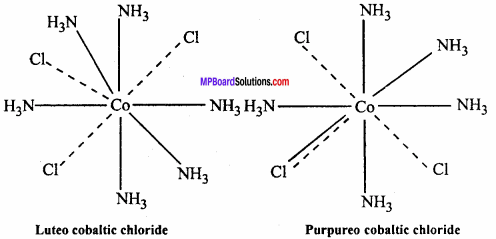
Question 2.
List various types of isomerism possible for co – ordination compounds, giving an example of each. (NCERT)
Answer:
Isomerism in Co – ordination Compounds:
Two or more compounds having the same molecular formula but different arrangement of atoms are called isomers.
Isomerism in Co – ordination Compounds is given below:

1. Structural Isomerism
This type of isomerism arises due to the difference in structures of co-ordination compounds. It is further sub divided into four different types as explained below :
(a) Ionization Isomerism:
This type of isomerism is shown by such compounds which have same composition but liberate different ions in solution.
[CO(NH3)5Br] SO4 – It liberates SO2- ions.
[CO(NH3)5SO4]Br – It liberates Br– ions.
(b) Co – ordination isomerism:
This type of isomerism is shown by such compound which contain both cationic and anionic species and it arises from the interchange of ligands between cationic and anionic entities of different metal ions present in a complex.
For example, [CO(NH3)6][Cr(CN)6 and [Cr(NH3)6][CO(CN)6]
hexaamminecobalt (III) hexacyano chromate (III) and hexaamminechromium (III) hexacyanocobalt (III).
(c) Linkage isomerism:
Linkage isomerism occurs when different atoms of the ligand are attached to the central metal ion. The structure obtained are called linkage isomers. Such type of ligands are called ambidentate ligand.
![]()
(d) Hydrate Isomerism:
This isomerism arises when different number of water molecules are present within and outside the co-ordination sphere. For example, three hydration isomer of CrCl3.6H2O are :
(i) [Cr(H2O)6]Cl3 All the six water molecules act as ligand
(Violet)
(ii) [Cr(H2O)5Cl]Cl2.H2O Five water molecules acts as ligand while one molecule
(Green)
of water as crystallization.
(iii) [Cr(H2O)4Cl2]Cl.2H2O Four water molecules acts as ligand, while the two molecules of water as crystallization.
(Green)
2. Stereoisomerism:
Two compounds are called stereoisomers when they contain the same ligand in their co – ordination sphere but differ in their spatial arrangement. Stereoisomerism is further classified as geometrical and optical isomerism.
(a) Geometrical Isomerism:
When the ligands are situated at different position around the metal it gives rise to geometrical isomerism. The isomer in which similar groups are in adjacent position (making an angle 90° with metal ion) is called cis – isomer. (MPBoardSolutions.com) The isomer in which the similar group occupy the opposite position (making an angle of 180° with metal ion) is called transisomer. This type of isomerism is observed in square planar (CN = 4) and octahedral (CN = 6) type of complexes.

(b) Optical Isomerism:
This type of isomerism is observed in such similar compounds which are the mirror images of each other and are non- superimposable. They rotate the path of plane polarized light to the left (l) or to the right (d).

Question 3.
Explain crystal field theory.
Answer:
This theory was proposed by Bethe and Von Black. According to this theory bonding between central metal ion and ligand is due to pure electrostatic attraction. If ligand is anion then attraction towards cation, is just like the attraction between two oppositely charged particles. If ligand is neutral molecule then the anionic end of this dipole is attracted to central positive ion. Thus, bonding between them is due to ion – ion attraction or ion dipole attraction.
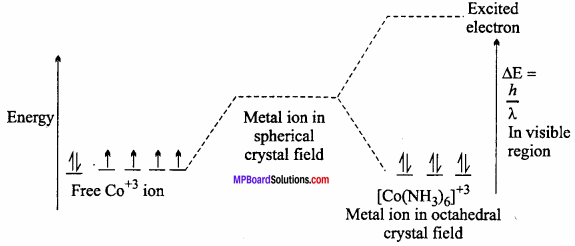
In crystal field theory due to approaching ligands the d – orbitals split into different energy levels on the basis of extent of splitting (depend on metal ion and nature of ligand) structure and properties of complex can be discussed. (MPBoardSolutions.com) Colour of transition metal complex is due to absorption of visible light which leads to excitation of electron from one d – orbital to the other d – orbital (d – d transition). This way this theory is easy and successfully explains maximum properties of the complexes.